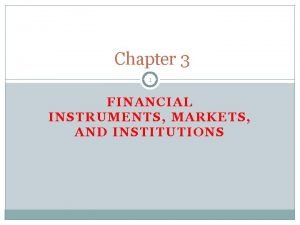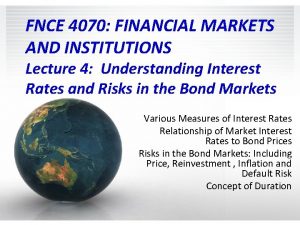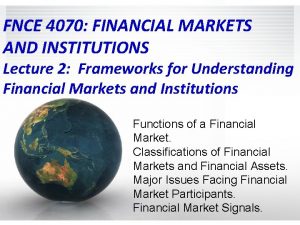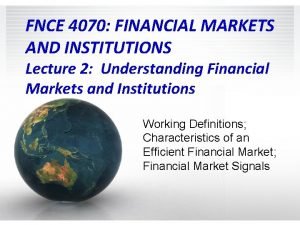Market Segmentation Theory FNCE 4070 Financial Markets and











- Slides: 11

Market Segmentation Theory FNCE 4070 Financial Markets and Institutions

Market Segmentation Theory • This theory states that the market for different -maturity bonds is completely separate and segmented. • The interest rate for a bond with a given maturity is determined by the supply and demand for bonds in that segment with no effect from the returns on bonds in other segments.

MST • We will consider the following market structure: – Two sectors – government bonds and corporate bonds – Two maturities – short-term and long-term

MST Demand • Most important factors determining demand for shortterm (long-term) bonds are: – – – The interest rate on the bonds Government policy Wealth Liquidity Risk • The demand for short-term (long-term) bonds in one sector is inversely related to the demand in another sector (corporates vs government) but is not related to demand for the long-term (short-term) bonds in either sector

MST Supply • The supply for short-term and long-term corporate bonds are related to their – Price/interest rate – General economic conditions • Increasing in economic expansions • Decreasing in recessions • The supply of Treasury Bonds depends only on government actions (monetary and fiscal policy) • The supply of Treasury Bonds does not depend on the economic state or interest rates – The sale or purchase of treasury securities by the central bank or the treasury is a policy decision – This implies that the supply curve for Treasury bonds is vertical.

Market Segmentation Theory

Case 1: Economic Recession • Suppose the economy moves from a period of economic growth into a recession – Business demand for short-term and long-term assets teds to decrease. – Thus business supply for short-term and long-term bonds tends to decrease. – Creates excess demand for corporate bonds • Drives bond prices up and interest rates down. – Increased demand for corporate bonds increases demand for treasury bonds at existing yields • Drives treasury bond prices up and government interest rates down.

Case 2: Treasury Financing • Interest rates on Treasuries depends, in part, on the size and growth of the federal government debt. • If deficits are increasing over time then the Treasury will be constantly trying to raise funds in the markets • The choice of securities affects the yield curve for treasury bonds and by substitution the yield curve for corporates.

Case 2: continued • By choosing which securities to finance the deficit with the federal government can push short term rates upwards or long term rates upwards. • By substitution these actions will have a similar effect on the corporate yield curve

Case 3 : Open Market Operations • Expansionary OMO in which it buys short-term securities will cause the yield curve to become positively sloped • Expansionary OMO in which it buys long-term securities will cause the yield curve to become negatively sloped • Contractionary OMOs work in the opposite direction

Preferred Habitat Theory • Investors and borrowers have preferred maturity segments. • They may stray away from their desired maturity segments if there are relatively better rates to compensate them.
 Segmentation targeting and positioning
Segmentation targeting and positioning The market segmentation theory
The market segmentation theory Why study financial markets and institutions?
Why study financial markets and institutions? Participants in money market
Participants in money market Financial markets and institutions - ppt
Financial markets and institutions - ppt What is financial intermediation
What is financial intermediation International financial markets and instruments
International financial markets and instruments Capital markets and financial intermediation
Capital markets and financial intermediation Secondary financial markets
Secondary financial markets Efficient capital allocation
Efficient capital allocation Types of exchange rate
Types of exchange rate Basic flow of funds through the financial system
Basic flow of funds through the financial system





















